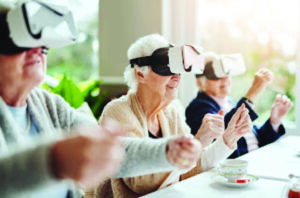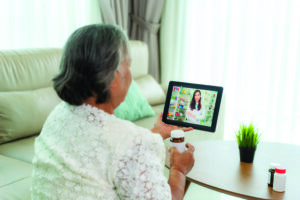 Trends in technology for older adults highlight continued adaption in a variety of services, including health care.
Trends in technology for older adults highlight continued adaption in a variety of services, including health care.
Older adults are continuing to live better because of technological innovation. A recent AARP report about tech trends shows that adults over 50 have nearly as high an adoption rate for smartphones, wearables, voice assistants and smart home technologies as their younger counterparts.
Tech Adaption Increases
Older adults are streaming movies, video-chatting with friends and family, and buying plenty of smart devices such as tablets and home security systems. COVID-19 was the tailwind that spurred increased acceptance of technology while we couldn’t get together in person. Spending on devices such as smart TVs, smartphones and Bluetooth headsets skyrocketed as older adults changed how they consume entertainment.
However, that’s not to say that barriers to adoption don’t exist for older adults. More than half were eager to learn more about how to use technology, and over a third said they’d use technology more often if they knew how. The three top barriers cited were cost, lack of knowledge, and concerns around privacy. The majority (83%) were not confident that what they do online remains private.
Finally, there are still disparities relating to access. Some relate to cost, which is an issue for about a quarter of older adults. But a quarter of rural consumers cited a lack of access, including 15% who either don’t have internet access or are not sure if they do.
So, knowing that tech is increasingly prevalent in the lives of older adults, let’s look at what’s catching on. Sheri Rose, director of the Thrive Center nonprofit that provides education on tech for older adults and looks at trends, highlights five areas where home tech and delivery models are morphing.
1. Tech to support independent living. The kitchen is changing, from induction cooktops that can’t burn a user to fridges that let users see the contents without opening the door and remind users when product is expiring. Those lacking the full pocketbook for a fancy fridge can take advantage of a voice assistant — one that can be paired with other devices to move the thermostat, see who’s at the door, or turn on the lights. Sensors can help family members living elsewhere keep tabs on a loved one by detecting motion via laser scanning or measuring changes in gait and thus the likelihood of a fall.
2. Wearables for health data. A plethora of wearable products is available to help users monitor their own health. Of course, there are the iconic Apple Watch and Fitbit, but you can also find Wi-Fi-enabled pulse oximeters and blood pressure monitors that will reduce visits to the doctor or alert when the measurement is abnormal. “Chronic heart failure and other comorbidities can be monitored remotely and help seniors avoid exposure to the virus, keeping them safe and healthy at home,” Rose says. “Smart tablets designed for seniors have integrated data collected from wearables. While you’re playing solitaire on your tablet, you get an alert that you need to take a walk or take your heart medication.”
3. Telehealth is taking off. The pandemic spurred adaption of remote health visits, made possible by secure videoconferencing platforms and improvements in camera sensitivity, making it possible for doctors to diagnose a rash or assess healing.
4. Virtual reality is viable entertainment. The isolation of COVID-19 corresponded with an uptick in the use of virtual reality (VR) systems. Thrive Center seniors have been overwhelmingly positive in their assessment of the technology. “We see older adults visit Thrive and put on a VR headset, and they get so enthralled with sitting on the beach and meditating,” Rose says. “We do so much with virtual reality because we know the impact it can have on reducing pain, loneliness and stress levels.”
5. 5G will make a difference. The fifth-generation cell service is set to boost speeds up to 100 times over current levels, and users will have to be trained in best-practice cybersecurity measures before joining up. Older adults may see the most benefit in the healthcare delivery arena. “5G is really going to boost a lot of download and upload capacity. When deployed, I think it will make a huge difference,” Rose says.
It’s clear that technology use is on the rise among older adults. Senior living facilities may soon be competing based on their tech offerings, as well as more traditional amenities.
SOCIETY OF CERTIFIED SENIORADVISORS
The SCSA educates and supports specialists in aging dedicated to improving lives of older adults.
1-800-653-1875 | csa.us
Sources:
https://healthtechmagazine.net/article/2021/01/whats-next-senior-tech-5-insights-thrive-center
https://www.rendever.com
https://www.rendever.com/rendeverfit
https://www.aarp.org/research/topics/technology/info-2021/2021-technology-trends-older-americans.html




Leave a Reply